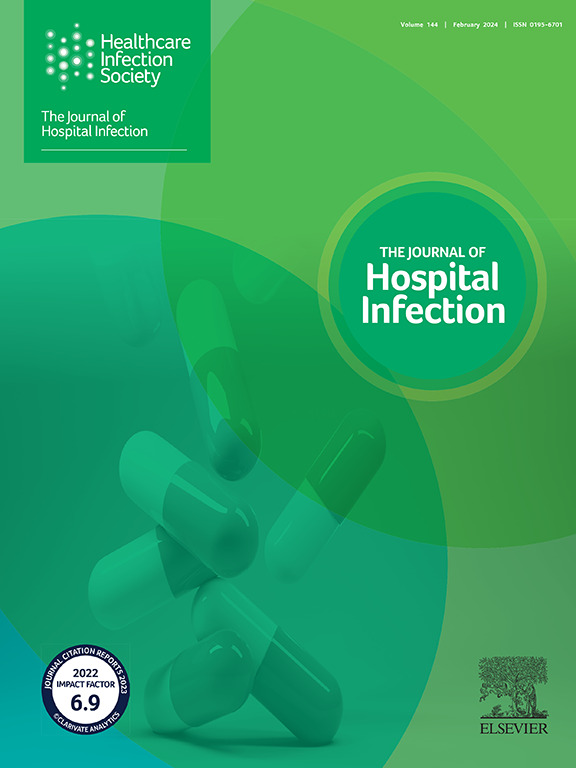监测妇科超声的卫生习惯:一种新方法。
IF 3.1
3区 医学
Q1 INFECTIOUS DISEASES
引用次数: 0
摘要
背景:超声在妇产科中是必不可少的,但不适当的卫生习惯会造成感染风险。虽然与超声波直接相关的感染很少,但消毒不良会促进微生物的传播。本研究评估卫生习惯和污染在超声咨询,以改善感染控制使用新的审计方法。目的:利用一种新的审核方法评估妇科超声会诊期间的卫生习惯,评估会诊后的微生物污染,并将实践与污染水平相关联,以优化方案。方法:记录会诊期间使用的卫生相关耗材,并与基于现行指南的目标进行比较。会诊后从探针和表面采集微生物样本。一项调查评估了医疗保健专业人员的知识和看法。在初始审核后进行了个性化培训,随后进行了控制审核。结果:初步审核显示卫生方面存在较大差距,特别是在手卫生和探针消毒方面。使用率指标低于100%。经过针对性的培训,他们超过了120%的目标。最初的污染很高(探针的中位CFU: 15,表面的中位CFU: 29),尤其是腹部探针。培训后,污染显著减少(Kruskal-Wallis, p)结论:这种创新的审核工具有效地评估了卫生状况,没有观察者偏见,并作为良好实践的可靠指标。结合调查,提供客观数据。有针对性的培训提高了依从性。对患者之间的所有超声部件(包括未使用的探头)进行严格消毒仍然是减少感染风险的必要条件。本文章由计算机程序翻译,如有差异,请以英文原文为准。
Monitoring hygiene practices in gynaecological ultrasound: a new approach
Background
Ultrasound is essential in gynaecology and obstetrics, but inadequate hygiene practices can pose infection risks. Though infections directly linked to ultrasound are rare, poor disinfection facilitates microbial transmission. This study evaluates hygiene practices and contamination during ultrasound consultations to improve infection control using a new audit methodology.
Aim
To assess hygiene practices during gynaecology ultrasound consultations using a new audit approach; to evaluate microbial contamination post-consultation; and to correlate practices with contamination levels to optimize protocols.
Methods
Hygiene-related consumables used during consultations were recorded and compared to targets based on current guidelines. Microbiological samples were taken from probes and surfaces after consultations. A survey assessed healthcare professionals' knowledge and perceptions. Personalized training was conducted after initial audits, followed by a control audit.
Findings
Initial audits showed major gaps in hygiene, especially regarding hand hygiene and probe disinfection. Indicators of usage were <100%. After targeted training, they exceeded 120% of objectives. Initial contamination was high (median cfu: 15 on probes, 29 on surfaces), especially on abdominal probes. Post training, contamination significantly decreased (Kruskal–Wallis, P < 0.05). Detected flora included Gram-positive cocci and pathogens such as Enterobacter hormaechei, Staphylococcus aureus, and Pseudomonas spp.
Conclusion
This innovative audit tool effectively assesses hygiene without observer bias and serves as a reliable indicator of good practice. Combined with the survey, it provides objective data. Targeted training improved compliance. Rigorous disinfection of all ultrasound components (including unused probes) between patients remains essential to minimize infection risks.
求助全文
通过发布文献求助,成功后即可免费获取论文全文。
去求助
来源期刊

Journal of Hospital Infection
医学-传染病学
CiteScore
12.70
自引率
5.80%
发文量
271
审稿时长
19 days
期刊介绍:
The Journal of Hospital Infection is the editorially independent scientific publication of the Healthcare Infection Society. The aim of the Journal is to publish high quality research and information relating to infection prevention and control that is relevant to an international audience.
The Journal welcomes submissions that relate to all aspects of infection prevention and control in healthcare settings. This includes submissions that:
provide new insight into the epidemiology, surveillance, or prevention and control of healthcare-associated infections and antimicrobial resistance in healthcare settings;
provide new insight into cleaning, disinfection and decontamination;
provide new insight into the design of healthcare premises;
describe novel aspects of outbreaks of infection;
throw light on techniques for effective antimicrobial stewardship;
describe novel techniques (laboratory-based or point of care) for the detection of infection or antimicrobial resistance in the healthcare setting, particularly if these can be used to facilitate infection prevention and control;
improve understanding of the motivations of safe healthcare behaviour, or describe techniques for achieving behavioural and cultural change;
improve understanding of the use of IT systems in infection surveillance and prevention and control.
 求助内容:
求助内容: 应助结果提醒方式:
应助结果提醒方式:


